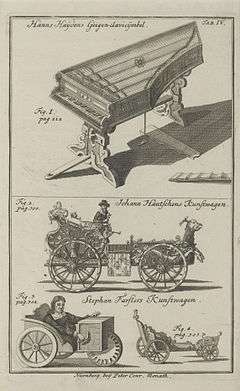Clavicymbalum
The clavicymbalum (or clavisymbalum, clavisimbalum, etc.) is an early keyboard instrument and ancestor of the harpsichord. The instrument is described as a psaltery to which keys, but no dampers, have been attached, allowing the keys rather than the fingers to pluck the strings, which then ring until their sound fades out. (The illustration on this page does not show the clavicymbalum just described. Rather, it shows a much later instrument on which the strings were played by multiple revolving, round bows.) [2]

One of its earliest attestations is a 1323 work by Johannes de Muris, where it describes a monochordium as an instrument "with a keyboard of two octaves, of triangular form, with one of the three sides curved."
The work of Henri-Arnault de Zwolle (between 1438 and 1446) describes the clavicymbalum as one of the "three types" of keyboard instruments, along with the dulce melos (an early piano) and the clavicordium (clavichord).[3]
References
- Doppelmayr 1730.
- Edward L. Kottick (2003). A History of the Harpsichord. Indiana University Press. pp. 20–. ISBN 0-253-34166-3.
- Roland Jackson (23 October 2013). Performance Practice: A Dictionary-Guide for Musicians: A Dictionary-Guide for Musicians. Taylor & Francis. pp. 94–. ISBN 978-1-136-76769-2.
Further reading
- G. Le Cerf et E.R. Labande, Les traités d'Henri-Arnault de Zwolle et de divers anonymes, Paris, 1932
- Martin-K. Kaufmann, "Le clavier à balancier du clavisimbalum XVe: un moment exceptionnel de l'évolution des instruments à clavier", in La Facture de clavecin du XVe au XVIIIe, Actes du colloque international de Louvain, 1976, Musicologica neolovaniensia. Studia 1, Louvain-la-Neuve, 1980, pp. 9-57.
- The Clavisimbalum of Henri Arnaut de Zwolle. Carl Rennoldson, Harpsi.com
- Thomas Steiner (2004). Instruments À Claviers, Expressivité Et Flexibilité Sonore: Actes Des Rencontres Internationales Harmoniques. Peter Lang. pp. 89–. ISBN 978-3-03910-244-0.
- Johann Gabriel Doppelmayr (1730). Historische Nachricht von den nürnbergischen Mathematicis und Künstlern. Nürnberg: Peter Conrad Monath. p. 341. (Original from: the University of Michigan; Digitized: 6 Mar 2012; Length: 314 pages)